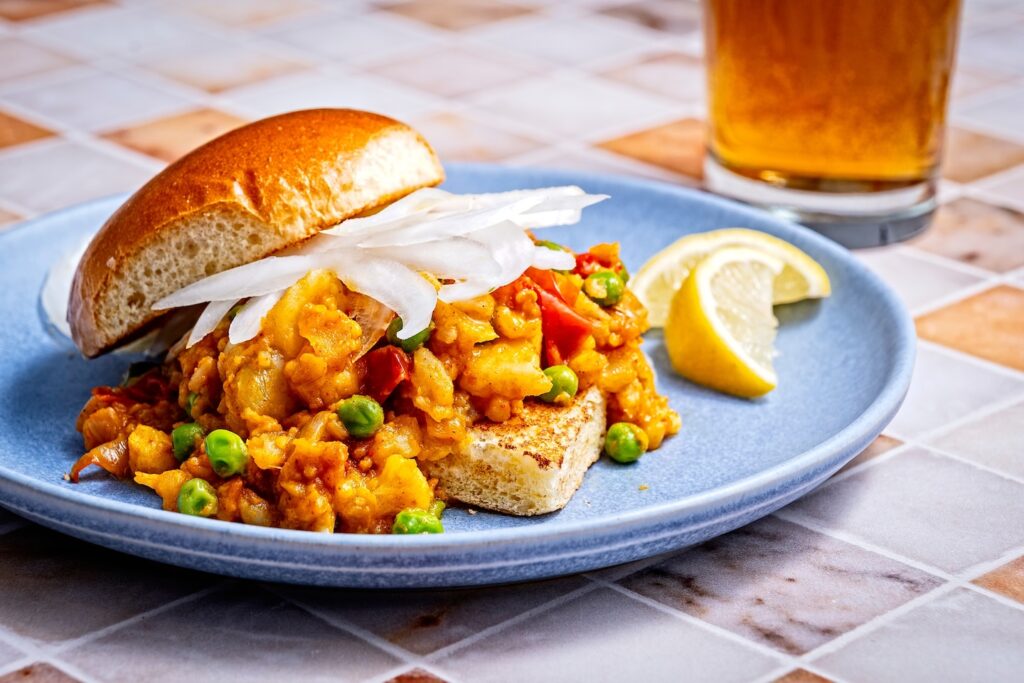In her first masterful cookbook, Amrikan, Khushbu Shah takes aim at one of the cliches of Western food criticism: linking foreign dishes to their American equivalents, no matter how far-fetched. Take, for example, pav bhaji, a toasted bread (pav) served with seasoned mashed vegetables (bhajis). “People like to describe it as an ‘Indian Sloppy Joe,’ but although it looks similar, it tastes completely different,” she writes.
Using something familiar to describe something unfamiliar isn’t necessarily a bad thing, but the choice often says more about the writer and intended reader than it does about the food itself.
Get the recipe: Pav Bhaji
Shah is no purist. In a Zoom interview, she emphasized that the idea of ”fusion” gets a bad rap because it’s often not done with intention and respect. “People say, ‘Oh, I’m just going to combine this and that and just mix it up,’ but they don’t really think about how they’re going to combine them,” she says. “But fusion is the crossroads of cultures. When cultures cross, cuisine evolves.”
Shah’s book is an ode to the Indian immigrant cuisine that defined her Michigan upbringing. “I grew up eating quesadillas, but I also grew up eating aloo parathas and stir-fried cabbage and dishes heavy on turmeric and Kashmiri red chili powder,” she says. “All of these foods are equally representative of my upbringing, my palate, so it’s only natural that they would start to intersect — not just on my palate, but on the plates of other people who are part of this immigration.”
Shah’s book reflects her personality: vibrant, creative, outspoken, thoughtful, and fun-loving. (Think of a title that captures the way Indian Americans say “American.”) She grew up in a vegetarian household, so the book’s content is mostly vegetarian, with a bit of meat in it, reflecting the “complex and intricate relationship with meat” Indians have historically had. “Many Indian immigrants come from upper-caste cultures that tend to be vegetarian,” she writes.
Before leaving Food & Wine, Shah became the first person of color to be a national restaurant critic, and spent years crisscrossing the country in search of the best restaurants of all types, trying out every Indian restaurant she could along the way. That research, combined with her childhood nostalgia, has resulted in recipes that range from classics like dal makhani and chana masala to more creative creations like saag paneer lasagna, green chutney pizza, and jalapeño popper samosas.
But as Shah points out, what may seem untraditional to purists is standard in her world. For example, she uses Bisquick to make gulab jamun, a method that would confuse Indians in India. “No one who immigrates to America is surprised by that,” she says. “They’re like, ‘Oh yeah, my mom does that too.'”
Meanwhile, pav bhaji is one of the staple dishes featured in the book that is treated as traditional because people who have migrated abroad still tend to make it that way. And it is already a product of fusion. According to Shah, pav originated on the west coast of India, where it was brought to the country by Portuguese colonization as a soft bread roll. Shah uses grilled potato rolls or hamburger buns for easy preparation.
This dish is surprisingly flexible in other ways, too. Though it typically calls for potatoes and peas, you can use whatever veggies you have on hand that you can mash. Shah also calls for cauliflower, but the first time I made it, I was bringing it as part of a meal for a friend who doesn’t like cruciferous vegetables, so I doubled the peas instead. My husband hates peas, so at home I doubled the cauliflower.
Either way, pav bhaji’s enduring appeal lies in its variety of flavors and textures: a spicy tomato-and-onion gravy coats mild vegetables, while coarse-yet-soft mashed potatoes contrast with grilled bread and, as Shah prefers it, “a mountain of raw onions.”
In fact, pav bhaji is one of Mumbai’s most famous street foods; Shah calls it “the ultimate late-night snack.” Its biggest similarity to the retro American sandwich is its sloppiness. So the next time I come across a sloppy joe, I’m going to call it “American pav bhaji.” Loudly and proudly.
Get the recipe: Pav Bhaji


